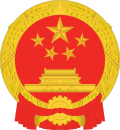
Back دستور جمهورية الصين الشعبية Arabic Constitución de la República Popular China AST Constitució de la República Popular de la Xina Catalan Folkerepublikken Kinas forfatning Danish Verfassung der Volksrepublik China German Σύνταγμα της Λαϊκής Δημοκρατίας της Κίνας Greek Constitución de la República Popular China Spanish Hiina Rahvavabariigi põhiseadus Estonian قانون اساسی چین Persian Constitution de la république populaire de Chine de 1982 French
| Constitution of the People's Republic of China | |
|---|---|
 Cover of the current constitution | |
| Overview | |
| Original title | 中华人民共和国宪法 |
| Jurisdiction | China |
| Ratified | September 20, 1954 |
| Date effective | September 20, 1954 |
| System | Unitary Marxist-Leninist one-party socialist republic |
| Government structure | |
| Branches | Six (Legislative, Executive, Military, Supervisory, Judicial, Procuratorial) |
| Head of state | President[a] |
| Chambers | Unicameral (National People's Congress)[b] |
| Executive | State Council headed by the Premier of the State Council |
| Judiciary | Supreme People's Court Supreme People's Procuratorate |
| Federalism | No - Decentralization within a Unitary State (special administrative regions) |
| Electoral college | Yes – the National People's Congress, which elects all other state authorities, is itself elected by two layers of Indirect election: County and Township People's Congresses elect the members of Provincial People's Congresses, who in turn elect the members of the National People's Congress. |
| History | |
| First legislature | September 21, 1949 (Chinese People's Political Consultative Conference) September 27, 1954 (National People's Congress) |
| First executive | September 27, 1954 (1st National People's Congress) October 1, 1949 (Central People's Government) |
| First court | October 22, 1949 |
| Amendments | 5 |
| Last amended | 11 March 2018 |
| Location | Beijing |
| Commissioned by | Constitution Drafting Committee |
| Supersedes | Common Program |
| Full text | |
| Footnote | |
| |
| Constitution of China | |||||||
|---|---|---|---|---|---|---|---|
| Simplified Chinese | 中华人民共和国宪法 | ||||||
| Traditional Chinese | 中華人民共和國憲法 | ||||||
| |||||||
 |
|---|
|
|
The Constitution of the People's Republic of China is the supreme law of the People's Republic of China (PRC). In September 1949, the first plenary session of the Chinese People's Political Consultative Conference adopted the Common Program, which acted as the temporary constitution after the PRC's foundation. On September 20, 1954, the first constitution was adopted by the first session of the 1st National People's Congress. The constitution went through two major revisions in 1975 and 1978. The current constitution was adopted by the 5th National People's Congress on December 4, 1982, with five subsequent revisions.
The current constitution consists of 4 chapters and 143 articles. It explains the nature of the People's Republic of China, highlights the concept of democratic centralism, and states that the People's Republic of China is a "socialist state governed by a people's democratic dictatorship that is led by the working class and based on an alliance of workers and peasants". It stipulates the central and local state institutions work under the system of people's congress, and states that China implements basic political systems such as the system of community-level self-governance and the regional ethnic autonomy system. The constitution also lists its basic national policies and establishes the leadership of the Chinese Communist Party (CCP).
© MMXXIII Rich X Search. We shall prevail. All rights reserved. Rich X Search